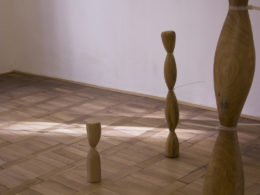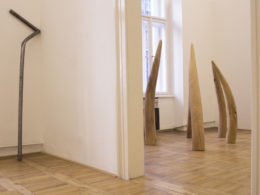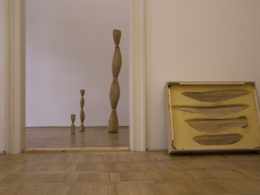UBRUS
Jan Turner
05/10/2018 - 23/11/2018
It is a small and almost insignificant step for a person, and even a little smaller would it be for an adult elephant, for example. Anyway, to get the essence of a problem, it is not always necessary to go somewhere, sometimes it’s enough to create a pretty little ubrus.
Of course, what is important is hidden in the details, they just differentiate the concepts and virtual images in our minds from the reality around us. Even a slight change, for example in the order of layers, can open the door to an entire alternative universe of relationships and contexts. Precisely such a focused probing below the surface of things is represented by a series of new objects by Jan Turner (*1971), an individualist who has never shifted from his demands on artistic creation as a means of constantly changing his own attitudes and a new look at the world, which he probably gained even with his unshakeable position on the periphery of the art scene. Like the Zen koans or the bounty of the current head of state, Turner’s works proclaim their paradoxical, relaxed openness to a barrage of logic and convention, liberating or instead disrupting our minds from stale concepts and expectations. Turner deliberately guides us through his works into specific mental situations that are not a different foundation than to arise from the conceivable and sensible, in other words: to reconfigure his image of the world. Often, he consciously balances himself at the edge of aesthetic acceptance, avoids moments of embarrassment, or is surprisingly sensitive to intimate positions, and shares his doubts about the barriers of the art world, while the hostile-looking “conceptual” symbolically deploys a civilian, human face.
curated by Pavel Švec



